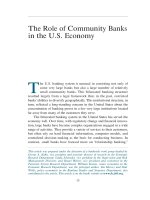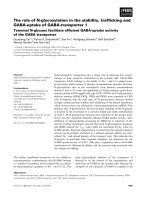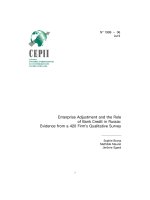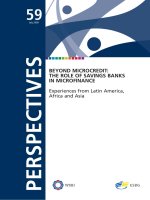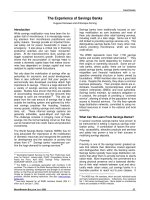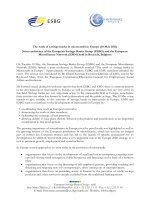BEYOND MICROCREDIT: THE ROLE OF SAVINGS BANKS IN MICROFINANCE potx
Bạn đang xem bản rút gọn của tài liệu. Xem và tải ngay bản đầy đủ của tài liệu tại đây (812.56 KB, 124 trang )
BEYOND MICROCREDIT:
THE ROLE OF SAVINGS BANKS
IN MICROFINANCE
Experiences from Latin America,
Africa and Asia
PERSPECTIVES
59
July 2009
BEYOND MICROCREDIT:
THE ROLE OF SAVINGS BANKS
IN MICROFINANCE
Experiences from Latin America,
Africa and Asia
ACKNOWLEDGEMENTS
WSBI wishes to thank all its member banks which have contributed to
this publication through the provision of input, case studies and figures.
The WSBI Institutional Relations team – Anne-Françoise Lefèvre, Hugues
Kamewe, Mina Zhang, Angela Arevalo, with the assistance of Juana
Muys Ramirez and Seth Landau – was responsible for the development of
the different reports presented in the document.
4
TABLE OF CONTENTS
Foreword 9
Section 1.: Microfinance: Description and recommendations
for enabling better development 11
1. Introduction: Characteristics of microfinance 13
1.1. What is microfinance? 14
1.2. Microfinance – broader than microcredit 15
1.3. Diversity of players 16
1.4. Microfinance and socially committed retail/savings banks 19
1.4.1. WSBI members: managing the double bottom-line
for consumer benefit 19
1.4.2. Microfinance – An institutional commitment and
a responsible business approach 21
1.5. Summary of the WSBI members’ microfinance approach
by region 22
1.5.1. Latin America 22
1.5.2. Africa 24
1.5.3. Asia/Pacific 26
2. Towards an enabling regulatory and supervisory framework 27
2.1. Tailoring frameworks to national circumstances 28
2.2. Gearing regulations towards activities rather
than institutions 28
2.3. Encouraging a diversity of players in a market-driven
environment 29
2.4. Making regulation proportionate to the expected benefits 29
2.5. Removing restrictions to microfinance activities and
associated prudential requirements 30
2.6. Allowing for increased deposit-taking activities 30
2.7. Allowing the recycling of deposits into lending 31
2.8. Revising regulations for payment systems 31
2.9. Encouraging linkages between banks, microfinance
institutions and other retail outlets 32
2.10. Implementing business rules to ensure
consumer protection 33
5
Section 2.: WSBI members’ experiences: A presentation
of regional leaders 35
Report 1. Microfinance in Latin America – The leadership of
WSBI members 37
1.1. The context: Microfinance in Latin America 38
1.2. Microfinance as carried out by WSBI Latin American
members 39
1.3. Microfinance products and services 43
1.3.1. Microcredit 43
1.3.2. Savings 46
1.3.3. Remittances 50
1.3.4. Insurance 53
1.4. Current trends 55
1.5. Short case studies of selected members 56
1.5.1. Peru - Federación Peruana de Cajas Municipales
de Ahorro y Crédito (FEPCMAC) 56
1.5.2. Chile – BancoEstado 57
1.5.3. Colombia – Banco Caja Social Colmena– BCSC 58
1.6. Bibliography/works cited 59
Report 2. Microfinance Services by Savings Banks in Africa –
The Sleeping Giants have started moving, but where are they going?
61
2.1. Summary 61
2.2. Main characteristics of microfinance in Africa 63
2.3. Savings banks in the microfinance landscape in Africa 66
2.4. Key features of African savings banks 68
2.4.1. Accessibility 68
2.4.2. Proximity 69
2.5. Products and services 70
2.6. Lending experiences 71
2.6.1. Retail lending: savings banks’ experiences
across Africa 72
2.6.2. The provision of microcredits 74
2.6.3. Small savings schemes 78
2.7. Diversifying into insurance and payment services 81
2.7.1. Commercialising insurance schemes 82
2.7.2. Payment facilities 83
2.8. Conclusions 87
2.9. Bibliography/works cited 89
6
Report 3. Microfinance in Asia/Pacific – Experiences of WSBI members
3.1. Snapshot of Microfinance in Asia/Pacific 91
3.1.1. Market structure and outreach 91
3.1.2. Microfinance actors 92
3.1.3. Microfinance models 93
3.2.
WSBI members’ intervention in microfinance in Asia/Pacific
94
3.2.1. Profile of WSBI members in Asia/Pacific 94
3.2.2. Main characteristics of WSBI Asian members’
microfinance activities 94
3.3. Selected case studies from members 96
3.3.1. Hatton National Bank (HNB), Sri Lanka –
Rural savings mobilisation and social development
through the Gami Pudubuwa programme 96
3.3.2. Vietnam Bank for Agriculture and Rural
Development (VBARD) – Services to rural market 100
3.3.3. National Bank for Agriculture and Rural
Development (NABARD), India – Self-Help Group
model to contribute to poverty alleviation in
rural areas 103
3.3.4. China Postal Savings Bank (CPSB) –
Accessible small-scale savings products 105
3.3.5. National Savings Institute (NSI), India –
Promotion and facilitation of small-scale savings 106
3.3.6. Government Savings Bank of Thailand (GSB) –
People Bank’s programme with a specific focus
on SME financing 107
3.3.7. Bank Simpanan Nasional (BSN), Malaysia –
Microfinance to finance micro and small enterprises
110
3.4. Bibliography/works cited 112
Annexes 115
Annex 1: WSBI Latin American members list 115
Annex 2: WSBI African members list 116
Annex 3: WSBI Asia/Pacific members list 117
Annex 4: General bibliography/works cited 118
7
8
8
9
I am delighted to present to you a new issue of Perspectives which
focuses on microfinance and the role of WSBI members. Access to
financial services at the microlevel has been shown to be critical for
developing economies and individual capacities – especially among poorer
populations. Savings and socially committed retail banks have long worked
towards financial inclusion and the betterment of their communities.
This issue of Perspectives examines the role of WSBI members in
improving access to finance and enhancing microfinance activities in the
Asia/Pacific, African, and Latin American regions. The document also
examines what must be done to enhance microfinance activities
throughout the world – turning a focus on microcredit into a focus on
general financial inclusion.
The world-wide movement towards financial inclusion is critical for
economic development in all geographic areas. This publication confirms
that savings banks and socially responsible retail banks play a leading role
in this effort and offer innovative and important products to serve middle
and lower income clients.
WSBI aims to continue to work with its members and international
organisations to capitalise on the progress being made amongst our
members throughout the world. I hope that this publication provides the
reader with a good overview of some of the important issues related to
microfinance.
Chris De Noose
Managing Director, WSBI
FOREWORD
10
11
SECTION 1.
MICROFINANCE: DESCRIPTION AND
RECOMMENDATIONS FOR ENABLING
BETTER DEVELOPMENT
12
13
13
This edition of Perspectives analyses the role of savings banks and WSBI
members in microfinance.
1
The first section discusses microfinance in
general. The second section presents WSBI’s recommendations for an
enabling regulatory framework for microfinance. Subsequently, this
publication provides more in depth and detailed analysis of the situations
in Latin America, Africa, and Asia – using examples from the experience
of WSBI members. These three analyses are independent reports which
can be read separately of one another. With this analysis, this edition of
Perspectives aims to contribute to the knowledge base regarding
financial inclusion and economic development and stimulate further
progress in this important area.
Two events have marked the recognition of microcredit as a core tool
to drive sustainable development: the United Nations 2005 Year of
Microcredit and the award of the Nobel Peace Price 2006 to the
microcredit “icon”, Professor Mohammad Yunus.
This momentum has been very helpful in bringing microfinance into the
spotlight not only in developing countries but also in the developed
world. The awareness by policy makers about the role of microfinance as
a major tool for empowering vulnerable people, addressing social and
economic exclusion, and alleviating poverty has grown significantly over
recent years. Consequently, the scope of this challenge has been
broadened to encompass the entire issue of financial inclusion, which
entails access to a full spectrum of financial services.
1. INTRODUCTION:
CHARACTERISTICS
OF MICROFINANCE
1 This publication covers microfinance offered by socially committed retail/savings banks
in Latin America, Africa and Asia/Pacific. For activities in Europe, see ESBG (2006) and
ESBG (2007).
The consensus by all stakeholders has been to incorporate the principle
of “Building of Inclusive Financial Sectors” into various aspects of
economic and business development.
2
The role of regulation and
supervision is crucial in this perspective. A regulatory environment that is
conducive to financial inclusion is important for government policy and
critical to widening access to financial services.
1.1. What is microfinance?
Microfinance is the provision of small-scale financial services to the poor or
the poorest among the poor. It is unique among economic development
initiatives because it has the ability to contribute directly to people’s
economic and social progress by allowing them to invest and multiply
their scarce assets. Although there is no standardized number to define
different “micro” products in quantification, it should be understood in
its broadest sense, covering a whole range of low value financial products.
One of the main reasons why conventional banking institutions have
concentrated their efforts on serving higher income segments of the
population is the operational and administrative costs linked to serving
“small” clients. Additionally, there is a higher risk (at least perceived)
associated with these services in dealing with lower income segments of
the population. However, there is also a demand for financial services
among underprivileged, low income people. This market gap has resulted
in a great significance being put on microfinance practices worldwide.
Successful microfinance institutions (MFIs) have developed effective ways
to empower vulnerable women and men, address social and economic
exclusion, and alleviate poverty by providing individuals the opportunity
to build assets as collateral and to improve their quality of life. Through
microfinance initiatives, previously unserved populations have proven to
be reliable clients.
The clients of microfinance institutions are typically low-income
individuals, who are self-employed or salaried. In rural areas, they may
generate income from farming, food processing or trading at the local
markets, whereas in urban areas they tend to be shop keepers, street
vendors, entrepreneurs, service providers, craftsmen, factory workers, etc.
14
2 With reference to the title of the Blue Book developed under the aegis of the United
Nations in the context of the Year of Microcredit. See UNCDF (2006).
14
They generally have income generating activities that are somewhat
unpredictable and may be seasonal but are more or less stable.
Nevertheless, these people often lack collateral, and in some cases they
have low levels of reading and writing skills. By serving this segment of
the population in developing and emerging economies the microfinance
industry has experienced significant growth in the past decade.
3
It has
increasingly been recognized that while not all people are eligible for
microcredit or would benefit from it,
4
all are deposit worthy, need to
make payments, and can benefit from insurance.
Thus, the importance of the microfinance movement today is the result
of an enlarged vision of banking – where financial inclusiveness plays an
important role in social and economic development, and where access to
finance for the poor represents an extension of the current offer of services.
1.2. Microfinance – broader than microcredit
In the eyes of the general public, microfinance tends to be limited
to microcredit. The United Nations naming 2005 Year of Microcredit
and the award of the Nobel Peace Price 2006 to the microcredit “icon”,
Professor Mohammad Yunus contributed to this recognition of microcredit
in particular as a core tool to drive sustainable development.
However, the scope of microfinance is broader. This includes providing an
adapted and diverse range of financial products and services to unserved
populations around the world. The term “microfinance” covers a whole
range of small amount financial products, including savings accounts,
insurance, national/international monetary transfer services, and
payments services (especially through non-cash transactions such as with
plastic cards, mobile phones, and other electronic devices).
15
3
The Microcredit Summit Campaign (2009) reported 2,931 MFIs reaching 80,868,343 clients
i
n 2003. 54,785,433 were among the poorest when they took their first loan. In 2006 they
reported 3,316 institutions reaching 133,030,913 clients. 92,922,574 were among the
poorest when they took their first loan. Taking into account recent figures the same
organization confirms that, having double-checked 80% of the figures totaling 3,552
microfinance organizations in 2007, the 100-million-poor mark was reached by the end of
2007. It is estimated that these organizations reached more than 150 million clients, of
which more 106 million were "poor", in Microcredit Summit Campaign (2009).
4 CGAP 2009b.
There is a need for policy-makers and regulators, at national, regional and
international level, to embrace this wider perspective and include all
actors involved in offering these types of services – not only microcredit
providers, into the scope of their microfinance-related initiatives.
Practitioners, academics and professionals “have long outgrown the
word microcredit. Today, the word microfinance doesn't even capture the
scope and scale of what is happening in the world of finance for the
poor. What was once a neat and tidy, well-delineated little sub-culture,
now encompasses a dizzying range of delivery organizations and services,
all increasingly interwoven with the rest of the financial sector. All around
the world, people are witnessing experimentation, and a surge of new
entrants to the microfinance field. The result is an explosion of diversity:
diversity of delivery channels, of services, of funding sources for MFI and,
of course, a variety of clients.”
5
1.3. Diversity of players
Many institutions have begun to provide microfinance services, either
because of concern for development or because of the business
opportunity presented or a combination of the two. Though it is difficult
to classify microfinance providers, it is still important to identify the various
models and understand the existing distinct approaches to microfinance.
There is significant diversity among the type of players in the
microfinance industry. This includes Self-Help Groups, Banking, Credit
and Savings Cooperatives, NGOs, as well as specifically regulated institutions
providing microfinance services like Postal Banks, Commercial and
Savings Banks. These actors do not necessarily offer the same kinds of
services. Most of these organisations provide microcredit. Others collect
savings. Authorized institutions do both. Still others act as “apex
institutions” which channel funding (grants, loans, guarantees, etc.) to
multiple MFIs in single country or region. This can sometimes include
supporting technical service. This is similar to the role sometimes played
by national development banks.
6
16
5 Littlefield 2005.
6 Levy 2009.
The reality today is that the growth of the microfinance industry has
inspired partnerships and knowledge transfer between organizations.
Microfinance providers are learning from each other and different models
are emerging at different levels in order to respond to different clients in
different contexts.
The first identifiable model among leading microfinance institutions is
that of NGOs with a social development background – some of which
have transformed and scaled up to become banks or regulated institutions,
supervised by the national authorities in their countries and responding
to the specificities of their markets. NGOs which have not become banks
can not be categorized as formal financial institutions. Therefore they are
not allowed to provide all manner of services – especially savings services
or products.
Semi-formal institutions like some NGOs, credit unions and cooperatives are
formal, registered entities subject to all relevant general laws – including
commercial laws – but informal as they are, with few exceptions,
not subject to banking regulation and supervision.
7
Having developed
a particular relationship with previously “unbanked” individuals, these
embedded microfinance institutions have succeeded in providing
financial services to poor and un-served populations.
Because of a lack of regulation for monitoring and supervising financial
NGO activities, these organisations are not usually allowed to collect savings,
but they are allowed to disburse microcredits. In fact, some successful
NGOs have proven able to achieve self sustainability. “Loan officers” and
their clients have been able to guarantee good loan repayment rates and
some NGOs have generated high quality portfolios.
Another model is represented by banks and other commercially oriented
institutions which use their branch infrastructure to reach out and serve
low income customers. Included among these institutions are the savings
and retail banks that are affiliated with the World Savings Banks Institute.
Savings banks’ primary concern is to mobilize financial resources and
invest these resources in the local economy.
17
7 CGAP 2009a.
They are considered socially committed for profit institutions and they
differ from microfinance initiatives that were created with a specific and
exclusive focus on credit. In most countries they have build up a reputation
as solid institutions that have proven effective in times of crisis and are
trusted by savers. Savings banks generally provide a sense of security for
low income clients thanks to their formal character and explicit (or
implicit) guarantee of deposits.
Commercial banks and socially committed retail/savings banks are formal
financial institutions. They are subject both to laws and regulations
which govern companies and to banking regulation and supervision.
Their importance in the microfinance field is based upon their
infrastructure and expertise in disbursing credits and securely collecting
and managing deposits. A number of them have efficient management
information’s systems and some are already involved in payments and
international remittances services, as well as insurance.
Some banks are active as guarantors for securitizing microfinance
portfolios. However, what distinguishes many WSBI members from purely
commercial banks is their social commitment, which is why their
microfinance activities are at the core of their retail business. They are
heavily involved in the mobilization of savings and their clients are
typically households, microenterprises and SMEs, essential actors to
foster development. Moreover, although the ownership structures of
WSBI members vary, they are all formal financial institutions strictly
regulated and supervised in order to protect clients and the markets
where they operate.
Another model results from a combination of the previous two – where
partnerships between socially-oriented microfinance institutions and banks
are being forged to take advantage of each other's comparative advantages.
There are some very sophisticated partnerships between important
NGOs, commercial banks, and investment funds. These organisations
have set up portfolio securitization schemes as alternative funding
strategies for NGOs forbidden to collect savings. Nevertheless, this type
of activity is not commonly undertaken by semi-formal NGOs. It is usually
limited to the bigger and most efficient ones.
18
Thus, different providers of microfinance services may have different
characteristics according to business orientation, target group, legal
status, ownership structure, capacity to mobilize savings, methodology
and regulation which affects them. However, all of them, whether they
are banks, non banks or other type of institutions, share the common
characteristic of providing financial services to an otherwise “unbanked”
population. For this reason, there is no need to favour only one model.
There is room for various approaches to microfinance and complementary
work and strategies are needed in order to build inclusive and responsible
financial systems, capable of serving a large range of clients and stakeholders
with different expectations and needs.
Thus, as microfinance grows, its development necessitates two necessary
avenues of action. First, business models must be adapted to different
contexts and different clients with different levels of income and
productivity. Second, appropriate regulation schemes, where necessary,
must be put into place that are proportionate to the expected benefits of
microfinance programmes and strike the right balance between the
mitigation of risk and the costs of implementation and compliance with
supervision and regulatory requirements.
Frameworks to organize microfinance activities should take into account
different levels of formality, sophistication, and activities and adapt to
national and regional circumstances with the objective to reach institutional
sustainability for the benefit of clients, create aggregated value and provide
quality financial services for a large amount of un-served populations.
1.4. Microfinance and socially committed retail/savings
banks
1.4.1. WSBI members: managing the double bottom-line for
consumer benefit
Savings banks are the largest element of institutions which target a
“double bottom-line” – both financial profit and servicing the interests of
the communities where they operate. These institutions explicitly target
customers not normally well served by purely shareholder-driven,
commercial banks.
19
WSBI members are large stakeholders in the microfinance market. They are
ideally equipped to be the leading providers of microfinance services in
their home countries:
n
They are accessible. WSBI members are geographically close to people
due to their widespread branch networks and nationwide coverage.
In many countries, savings and postal savings banks are the only
financial institutions that reach extensively remote areas.
n They have significant outreach among the poorest households
in their countries. For example, one of WSBI members in India, the
National Savings Institute, reaches 6 million of the poorest households
and the WSBI member in Thailand, the Government Savings Bank,
reaches 4.5 million.
8
n
They have relatively low requirements for accessing their services
.
WSBI members have a wealth of assets in terms of branch infrastructure
and institutional knowledge, which allows them to achieve economies
of scale and thus be able to offer affordable financial products.
n They provide a whole range of financial services in a sustainable
manner. WSBI members are the biggest providers of savings accounts
(1.1 billion)
9
and significant providers of loan accounts (30+ million).
10
Some WSBI members are also active in offering remittance products
and many of them have specialized microinsurance products.
Savings banks have a clear dual mandate. They work on promoting
access to financial services for all un-banked communities and individuals
in the various territories where they operate. At the same time, they are
impelled to make reasonable profits so that the outreach achieved can be
sustained without constant recourse to public or charitable subsidies.
Hence, recognizing the importance of their stability as engines for social
and economical development, savings banks have the mission to grow
with the communities they serve. For this reason, the decision to provide
affordable financial services for un-served customers and to maintain a
broad retail distribution network distinguishes saving banks from purely
profit maximizing financial institutions.
20
8 WSBI 2008.
9 Peachey 2006b.
10 Peachey 2006a.
With 23 members from 16 countries in Asia and the Pacific, 34 members
from 31 countries in Africa and 15 members from 13 countries in Latin
America,
11
WSBI member banks share a business model based on a close
relationship with the retail customer and a sound knowledge of the
customer’s needs and capacities. Members act directly to facilitate access
to financial services and generate social inclusion in their respective
countries. At the same time, they act indirectly to finance social programs
from their profits made from a diversified financial pool of activities
within the region where they operate.
Savings banks are very large providers of financial services in all socio-economic
segments. They have both a strong breath of outreach – serving a large
percentage of the population – and significant depth of outreach as well –
reaching a large number of the poorest households. This is especially the
case in rural areas, but also in urban settings. This means that savings banks
hold great potential for delivering accessible financial services for all.
12
1.4.2.
Microfinance – An institutional commitment and a responsible
business approach
Institutional commitment is a prerequisite for providing low-income people
with financial services. The commitment of savings and socially committed
retail banks to providing financial services to underserved markets
distinguishes them from most other formal financial institutions. In addition
to the distribution of part of their profits for increasing social and financial
inclusion, WSBI member banks generally go further than other financial
institutions in their educational role to stimulate the mobilization of savings.
They set up campaigns that are innovative and add value to the bank in
addition to the marketing aspect. This pedagogical engagement and support
to initiatives aimed at achieving social and financial inclusion are other
expressions of the traditional social responsibility of WSBI member banks.
Savings banks and socially committed retail banks provide a wide range
of financial services in a sustainable manner. In this aspect they differ from
several microfinance institutions that depend on donor funding and offer
limited credit services. In most cases, savings banks and socially committed
retail banks have a diversified retail banking portfolio of services offered.
Therefore, they are able to raise income in different areas of the banking
business.
13
21
11 For a list of members, go to
12 Peachey 2008.
13 Peachey, et al. 2009.
Furthermore, as proximity banks, savings and socially committed retail
banks have essential assets that make them ideally equipped to provide
microfinance services. They are accessible because of their geographic
proximity given their wide spread branch networks and national and
regional wide coverage. Compared to other formal financial institutions
they also tend to have relatively low requirements for accessing their
services, especially low minimum balances for savings accounts.
14
A responsible approach to business is at the core of the WSBI members’
banking activities. For this reason, microfinance practices have been
traditionally important for members active in developing and emerging
economies.
1.5. Summary of the WSBI members’ microfinance
approach by region
Though the region-specific reports which are included in this “Perspectives”
will delve more deeply into the specific characteristics of microfinance
activities in various regions, it is worth briefly examining the basic
characteristics of WSBI member involvement in microfinance in Latin
America, Africa, and Asia/the Pacific.
1.5.1. Latin America
In Latin America, microfinance has experienced an enormous success with
a
vibrant sector of sophisticated and commercially oriented microfinance
providers. Indeed, most microfinance institutions in Latin America seek to
become commercial players in the financial sector, achieving impressive
records of financial and operational performance. Many of them are
integrated into the formal financial system, being banks or microfinance
specialized institutions, regulated by the financial authorities in their
countries.
22
14 WSBI 2004.
A recent regional survey
15
showed that in 2005, around 6 million people
received microcredits in Latin America and most of those credits (81%)
came from regulated institutions. The overall portfolio stood at around
USD 5.4 billion for the same year. In terms of growth, the survey revealed
annual growth rates of 35% in terms of the number of clients and 46%
in terms of the size of the portfolio. This confirms that the Latin American
microfinance industry is experiencing rapid expansion.
While microfinance in Asia and Africa has a stronger social focus on the
poor, microfinance in Latin America is mostly understood as a financial
solution for microentrepreneurs and their families. Thus, loan average
values are higher than those found in the other regions (USD 783 in Latin
America versus USD 121 for Asia and USD 187 for Africa).
16
It is also
mainly an urban activity, where individual credit methodologies
predominate over group lending. This differs from the large rural schemes
existing in Asia.
Microfinance providers in Latin America can be broadly characterized in
three categories. They are;
1. NGOs that have transformed into regulated institutions (upscaling)
2. banks that have entered into the microfinance market (downscaling),
or
3. traditional proximity financial institutions created to serve the micro -
entrepreneur market.
WSBI members which act as microfinance providers in the region belong
to the latter two categories. They are either banks with special
microfinance programs or proximity financial institutions dedicated to
microentrepreneurs.
23
15 Navajas and Tejerina 2006.
16 Data from MIX (2007a) – looking at median values of “Average Loan Balance per
Borrower” for Latin America, Asia and Africa for the year 2005.
WSBI Latin American members:
n Are large and long-established providers of microfinance services.
As proximity financial institutions with large networks and with a
strong social commitment, they are leaders in the Latin American
microfinance industry. A rough estimate indicates that they provided
microcredits to more than 1.45 million clients in 2006. They also
mobilized at least USD 779 million deposits from their microfinance
clients in that same year.
n Provide a full range of microfinance products. All of them mobilize
savings, which is one of their major advantages compared to other
microfinance providers focusing exclusively on credit. They also
provide remittance services and some of them are leaders in the
distribution of accessible insurance products.
n Are experiencing impressive growth both in terms of clients, portfolio
and savings collection. On average they have experienced 40%
portfolio growth rate and 30% client growth rate for each of the past
3 years (2004-2006).
1.5.2. Africa
Broadly speaking, African savings banks are providers of microfinance
services. However, they have historically not been classified among
microfinance institutions. The main reason is because the dominant
paradigm in microfinance until now merely recognises microcredit
institutions, which savings banks could not be (and still are not in many
cases) in Africa because of their institutional set-ups that commonly
prohibited any form of lending.
However, the definition of microfinance has evolved over recent years
from its narrow perspective. The scope of microfinance services now
largely take into consideration basic financial services that are needed by
vulnerable people. Recent research in the field of “Access to Finance” has
substantially contributed to changing how experts define microfinance.
There is a greater awareness that poor people even desire more safe and
affordable deposit services to protect their small savings. Their demand is
also very high for payment services (including money transfer services)
and insurance services.
24
This larger perspective of microfinance brings African savings banks in the
picture. However, their contribution to microfinance is still very often
overlooked by experts and policy makers. The purpose of this study is
to survey and give visibility to the activities of savings banks in this field.
It complements the summary report on Microfinance in Africa
17
with
hard evidence supported by data on these activities. The main findings of
this report are as follows:
n Savings banks in Africa have managed to provide convenient basic
financial services by combining accessibility (secure and affordable
financial services) and proximity (extensive retail distribution networks)
to their clients. Their potential comparative advantage in deposit-taking
services and money transfer services (including remittances) could be
further enhanced through payment facilities.
n Institutional set-ups are changing favourably, but the general trend for
savings banks is to reposition towards low-risk retail banking activities
and not to become pure microfinance institutions or microfinance banks.
n There are diverse business models to respond to the pressing market
demand for microcredit services. Some savings banks have introduced
a microcredit scheme in their product line (Tanzania, Zambia) or
opened a specialised window (Egypt) for direct participation while
other have opted for an indirect participation through linkages
(Uganda, Zimbabwe) with sustainable and promising microfinance
institutions (e.g., refinancing of wholesale loans for on-lending to
retail microfinance clients.
n Where savings banks are direct microcredit providers the individual
lending methodology has generated better results. Loan sizes vary
across countries from USD 50 to USD 2,000 (often group loans) but
are in line with the industry average while microloan portfolios range
between USD 100,000 and USD 8 million (at the National Bank for
Development in Egypt).
n Regulation is an issue for savings banks involved in microfinance
because they are subject to stringent banking regulations. Microcredit is
in principle uncollateralized lending and as such it is more demanding
for complying with prudential requirements. In general, regulation is a
limit to the expansion of microcredit programmes run by savings banks.
25
17 Pouye 2008.


